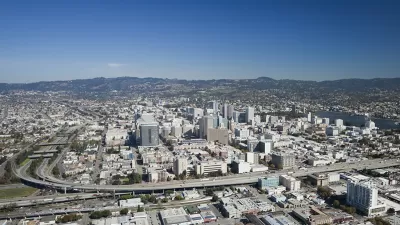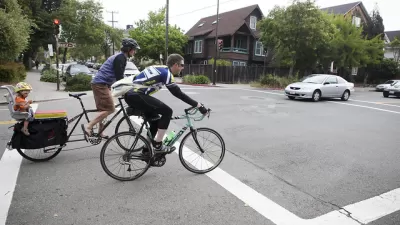Lauren Markham examines the value of community gardens to the bottom lines of developers—because one person's blighted back yard can easily become another person's veggie garden marketing pitch.
According to a recent article in The New Yorker, "for house buyers, these community gardens simply have aesthetic appeal, contributing to a kind of rustic, down-home vibe that makes nearby real estate more attractive. And it hasn’t taken long for real-estate agents and developers to take advantage of that commercial potential."
The article cites examples in the East Bay in Northern California, where low income neighborhoods have doubled as bohemian enclaves for decades, but new market pressures due to the region's booming tech economy are pushing low income residents out. "The 'blighted' lots suitable for urban agriculture are often found in lower-income neighborhoods like NOBE, as well as in post-industrial neighborhoods like West Oakland and West Berkeley. These also happen to be neighborhoods that developers see as ripe for construction."
In these cases, what began as a well-intentioned public health benefit, can transition into a signifier for gentrification. "Many community gardens are started with the intention of supporting lower-income communities, Tiny Gray Garcia, an activist and journalist, said. But once they are built, she added, 'the real-estate companies come in and start to reassess the land and use the property value to displace poor people of color. The community-gardening people may be well meaning, but they don’t always understand that they’re pawns in the game.'"
FULL STORY: Gentrification and the Urban Garden

Trump Administration Could Effectively End Housing Voucher Program
Federal officials are eyeing major cuts to the Section 8 program that helps millions of low-income households pay rent.

Planetizen Federal Action Tracker
A weekly monitor of how Trump’s orders and actions are impacting planners and planning in America.

Ken Jennings Launches Transit Web Series
The Jeopardy champ wants you to ride public transit.

Rebuilding Smarter: How LA County Is Guiding Fire-Ravaged Communities Toward Resilience
Los Angeles County is leading a coordinated effort to help fire-impacted communities rebuild with resilience by providing recovery resources, promoting fire-wise design, and aligning reconstruction with broader sustainability and climate goals.

When Borders Blur: Regional Collaboration in Action
As regional challenges outgrow city boundaries, “When Borders Blur” explores how cross-jurisdictional collaboration can drive smarter, more resilient urban planning, sharing real-world lessons from thriving partnerships across North America.

Philadelphia Is Expanding its Network of Roundabouts
Roundabouts are widely shown to decrease traffic speed, reduce congestion, and improve efficiency.
Urban Design for Planners 1: Software Tools
This six-course series explores essential urban design concepts using open source software and equips planners with the tools they need to participate fully in the urban design process.
Planning for Universal Design
Learn the tools for implementing Universal Design in planning regulations.
Ada County Highway District
Clanton & Associates, Inc.
Jessamine County Fiscal Court
Institute for Housing and Urban Development Studies (IHS)
City of Grandview
Harvard GSD Executive Education
Toledo-Lucas County Plan Commissions
Salt Lake City
NYU Wagner Graduate School of Public Service





























